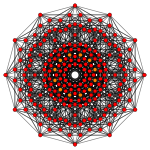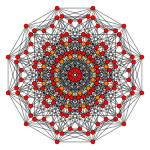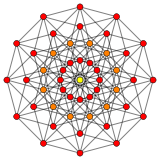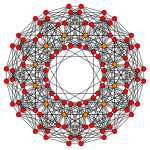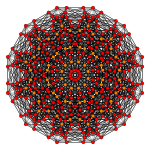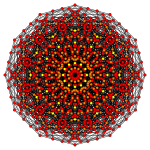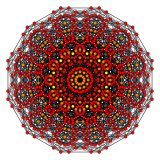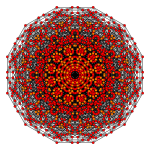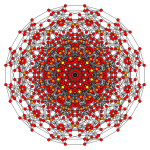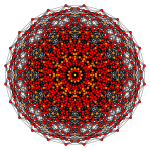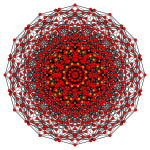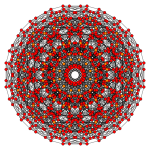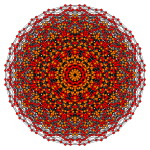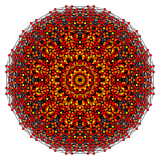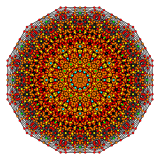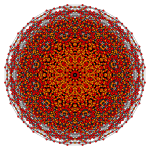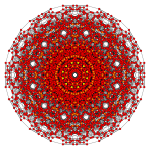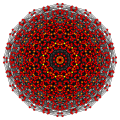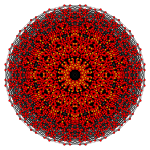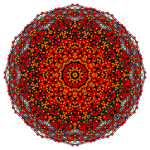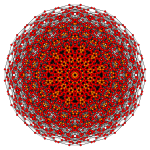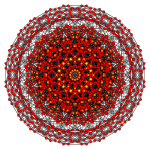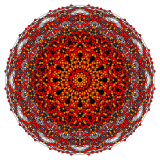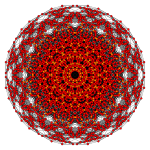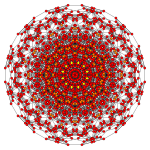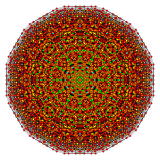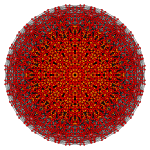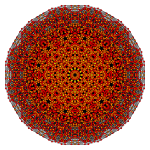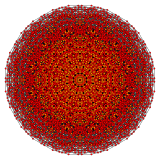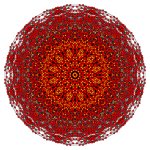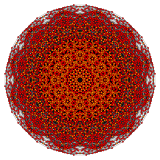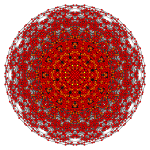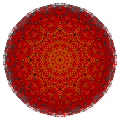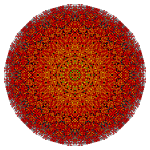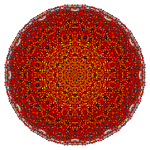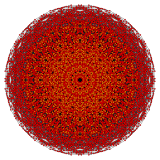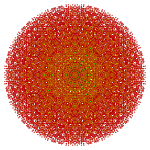6-orthoplex
| 6-orthoplex Hexacross | |
|---|---|
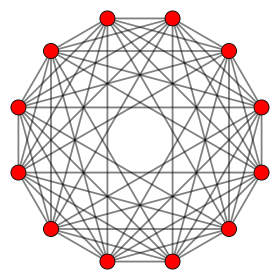 Orthogonal projection inside Petrie polygon | |
| Type | Regular 6-polytope |
| Family | orthoplex |
| Schläfli symbols | {3,3,3,3,4} {3,3,3,31,1} |
| Coxeter-Dynkin diagrams | |
| 5-faces | 64 {34} |
| 4-faces | 192 {33} |
| Cells | 240 {3,3} |
| Faces | 160 {3} |
| Edges | 60 |
| Vertices | 12 |
| Vertex figure | 5-orthoplex |
| Petrie polygon | dodecagon |
| Coxeter groups | B6, [4,34] D6, [33,1,1] |
| Dual | 6-cube |
| Properties | convex |
In geometry, a 6-orthoplex, or 6-cross polytope, is a regular 6-polytope with 12 vertices, 60 edges, 160 triangle faces, 240 tetrahedron cells, 192 5-cell 4-faces, and 64 5-faces.
It has two constructed forms, the first being regular with Schläfli symbol {34,4}, and the second with alternately labeled (checkerboarded) facets, with Schläfli symbol {3,3,3,31,1} or Coxeter symbol 311.
It is a part of an infinite family of polytopes, called cross-polytopes or orthoplexes. The dual polytope is the 6-hypercube, or hexeract.
Alternate names
- Hexacross, derived from combining the family name cross polytope with hex for six (dimensions) in Greek.
- Hexacontitetrapeton as a 64-facetted 6-polytope.
As a configuration
The elements of the regular polytopes can be expressed in a configuration matrix. Rows and columns reference vertices, edges, faces, and cells, with diagonal element their counts (f-vectors). The nondiagonal elements represent the number of row elements are incident to the column element. The configurations for dual polytopes can be seen by rotating the matrix elements by 180 degrees.[1][2]
Construction
There are three Coxeter groups associated with the 6-orthoplex, one regular, dual of the hexeract with the C6 or [4,3,3,3,3] Coxeter group, and a half symmetry with two copies of 5-simplex facets, alternating, with the D6 or [33,1,1] Coxeter group. A lowest symmetry construction is based on a dual of a 6-orthotope, called a 6-fusil.
| Name | Coxeter | Schläfli | Symmetry | Order |
|---|---|---|---|---|
| Regular 6-orthoplex | {3,3,3,3,4} | [4,3,3,3,3] | 46080 | |
| Quasiregular 6-orthoplex | {3,3,3,31,1} | [3,3,3,31,1] | 23040 | |
| 6-fusil | {3,3,3,4}+{} | [4,3,3,3,3] | 7680 | |
| {3,3,4}+{4} | [4,3,3,2,4] | 3072 | ||
| 2{3,4} | [4,3,2,4,3] | 2304 | ||
| {3,3,4}+2{} | [4,3,3,2,2] | 1536 | ||
| {3,4}+{4}+{} | [4,3,2,4,2] | 768 | ||
| 3{4} | [4,2,4,2,4] | 512 | ||
| {3,4}+3{} | [4,3,2,2,2] | 384 | ||
| 2{4}+2{} | [4,2,4,2,2] | 256 | ||
| {4}+4{} | [4,2,2,2,2] | 128 | ||
| 6{} | [2,2,2,2,2] | 64 |
Cartesian coordinates
Cartesian coordinates for the vertices of a 6-orthoplex, centered at the origin are
- (±1,0,0,0,0,0), (0,±1,0,0,0,0), (0,0,±1,0,0,0), (0,0,0,±1,0,0), (0,0,0,0,±1,0), (0,0,0,0,0,±1)
Every vertex pair is connected by an edge, except opposites.
Images
| Coxeter plane | B6 | B5 | B4 |
|---|---|---|---|
| Graph |  |
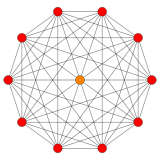 |
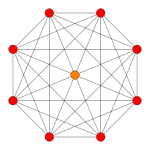 |
| Dihedral symmetry | [12] | [10] | [8] |
| Coxeter plane | B3 | B2 | |
| Graph |  |
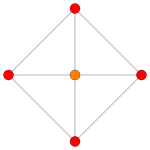 | |
| Dihedral symmetry | [6] | [4] | |
| Coxeter plane | A5 | A3 | |
| Graph | 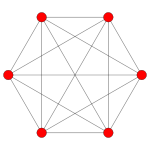 |
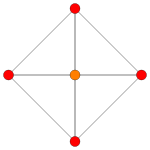 | |
| Dihedral symmetry | [6] | [4] |
Related polytopes
The 6-orthoplex can be projected down to 3-dimensions into the vertices of a regular icosahedron.[3]
| 2D | 3D | ||
|---|---|---|---|
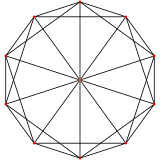 Icosahedron {3,5} = H3 Coxeter plane |
 6-orthoplex {3,3,3,31,1} = D6 Coxeter plane |
 Icosahedron |
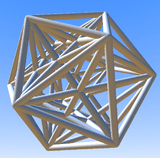 6-orthoplex |
| This construction can be geometrically seen as the 12 vertices of the 6-orthoplex projected to 3 dimensions as the vertices of a regular icosahedron. This represents a geometric folding of the D6 to H3 Coxeter groups: | |||
It is in a dimensional series of uniform polytopes and honeycombs, expressed by Coxeter as 3k1 series. (A degenerate 4-dimensional case exists as 3-sphere tiling, a tetrahedral hosohedron.)
| Space | Finite | Euclidean | Hyperbolic | |||
|---|---|---|---|---|---|---|
| n | 4 | 5 | 6 | 7 | 8 | 9 |
| Coxeter group |
A3A1 | A5 | D6 | E7 | =E7+ | =E7++ |
| Coxeter diagram |
||||||
| Symmetry | [3−1,3,1] | [30,3,1] | [[3<sup>1,3,1</sup>]] = [4,3,3,3,3] |
[32,3,1] | [33,3,1] | [34,3,1] |
| Order | 48 | 720 | 46,080 | 2,903,040 | ∞ | |
| Graph | 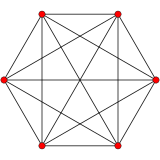 |
 |
 |
- | - | |
| Name | 31,-1 | 310 | 311 | 321 | 331 | 341 |
This polytope is one of 63 uniform 6-polytopes generated from the B6 Coxeter plane, including the regular 6-cube or 6-orthoplex.
References
- H.S.M. Coxeter:
- H.S.M. Coxeter, Regular Polytopes, 3rd Edition, Dover New York, 1973
- Kaleidoscopes: Selected Writings of H.S.M. Coxeter, edited by F. Arthur Sherk, Peter McMullen, Anthony C. Thompson, Asia Ivic Weiss, Wiley-Interscience Publication, 1995,
ISBN 978-0-471-01003-6
- (Paper 22) H.S.M. Coxeter, Regular and Semi Regular Polytopes I, [Math. Zeit. 46 (1940) 380-407, MR 2,10]
- (Paper 23) H.S.M. Coxeter, Regular and Semi-Regular Polytopes II, [Math. Zeit. 188 (1985) 559-591]
- (Paper 24) H.S.M. Coxeter, Regular and Semi-Regular Polytopes III, [Math. Zeit. 200 (1988) 3-45]
- Norman Johnson Uniform Polytopes, Manuscript (1991)
- N.W. Johnson: The Theory of Uniform Polytopes and Honeycombs, Ph.D. 1966
- Klitzing, Richard. "6D uniform polytopes (polypeta) x3o3o3o3o4o - gee".
- Specific
External links
- Olshevsky, George. "Cross polytope". Glossary for Hyperspace. Archived from the original on 4 February 2007.
- Polytopes of Various Dimensions
- Multi-dimensional Glossary
Fundamental convex regular and uniform polytopes in dimensions 2–10 | ||||||||||||
|---|---|---|---|---|---|---|---|---|---|---|---|---|
| Family | An | Bn | I2(p) / Dn | E6 / E7 / E8 / F4 / G2 | Hn | |||||||
| Regular polygon | Triangle | Square | p-gon | Hexagon | Pentagon | |||||||
| Uniform polyhedron | Tetrahedron | Octahedron • Cube | Demicube | Dodecahedron • Icosahedron | ||||||||
| Uniform 4-polytope | 5-cell | 16-cell • Tesseract | Demitesseract | 24-cell | 120-cell • 600-cell | |||||||
| Uniform 5-polytope | 5-simplex | 5-orthoplex • 5-cube | 5-demicube | |||||||||
| Uniform 6-polytope | 6-simplex | 6-orthoplex • 6-cube | 6-demicube | 122 • 221 | ||||||||
| Uniform 7-polytope | 7-simplex | 7-orthoplex • 7-cube | 7-demicube | 132 • 231 • 321 | ||||||||
| Uniform 8-polytope | 8-simplex | 8-orthoplex • 8-cube | 8-demicube | 142 • 241 • 421 | ||||||||
| Uniform 9-polytope | 9-simplex | 9-orthoplex • 9-cube | 9-demicube | |||||||||
| Uniform 10-polytope | 10-simplex | 10-orthoplex • 10-cube | 10-demicube | |||||||||
| Uniform n-polytope | n-simplex | n-orthoplex • n-cube | n-demicube | 1k2 • 2k1 • k21 | n-pentagonal polytope | |||||||
| Topics: Polytope families • Regular polytope • List of regular polytopes and compounds | ||||||||||||


